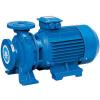




 1 votes
1 votes
Affinity Laws For Centrifugal Pumps As Applicable To Variable Frequency Drives
20 September 2012
 Variable Frequency Drives (VFDs) or Variable Speed Induction Motors are frequently used in many applications for flow control through centrifugal pumps. One common factor associated with VFDs used for centrifugal pumps is rapidly changing flow to meet the process requirements and power savings at turndown flow rates where an oversized motor will provide poor motor efficiencies. In certain applications where very large volumetric capacities need to be pumped using a centrifugal pump the advantages of using a VFD become obvious and the payback period is typically less than 36 months. With costs related to solid-state electronics coming down over the years, utilizing VFDs for centrifugal pumps and fans gives large power savings for a relatively small change in speed according to the affinity laws and thus has become very attractive. For detailed understanding of the working of VFDs refer the "Wikipedia" article at the link provided below:
Variable Frequency Drives (VFDs) or Variable Speed Induction Motors are frequently used in many applications for flow control through centrifugal pumps. One common factor associated with VFDs used for centrifugal pumps is rapidly changing flow to meet the process requirements and power savings at turndown flow rates where an oversized motor will provide poor motor efficiencies. In certain applications where very large volumetric capacities need to be pumped using a centrifugal pump the advantages of using a VFD become obvious and the payback period is typically less than 36 months. With costs related to solid-state electronics coming down over the years, utilizing VFDs for centrifugal pumps and fans gives large power savings for a relatively small change in speed according to the affinity laws and thus has become very attractive. For detailed understanding of the working of VFDs refer the "Wikipedia" article at the link provided below:http://en.wikipedia....frequency_drive
If we say that a 3000 rpm motor is operating at the rated frequency of 60 Hz, then if we can vary the frequency from 30 to 90 Hz using a VFD the motor rpm could be varied from 1500 rpm to 4500 rpm.
However, centrifugal pump operations have limitations and cannot be operated for such a wide turn-down availabe from the driver or motor. The practical limit for deviation from the nameplate Brake Horse Power (BHP) is -50% and +5%. The following reasons can be attributed for the aforementioned limitations:
- Below 50% BHP rating the power factor and efficiency can deteriorate to unacceptable values
- Above 5% BHP rating the motor tends to "saturate" wherein the current rises to unpredictable and unacceptable levels.
Let us move on to the affinity laws. The following relationship exists for centrifugal pumps for frequency based on affinity laws and considering a rated frequency of 60 Hz
New Motor RPM = (New or Changed Frequency / 60 Hz)*Motor RPM at 60 Hz
New Flow Rate = (New or Changed Frequency / 60 Hz)*Flow rate at 60 Hz
New Differential Head = (New or Changed Frequency / 60 Hz)2*Differential Head at 60 Hz
New BHP = (New or Changed Frequency / 60 Hz)3*BHP at 60 Hz
Let us take an example. For a pump of 100 BHP operating at 60 Hz, the BHP corresponding to 30 Hz would be 12.5 hp and corresponding to 90 Hz would be 337.5 hp. As explained above the practical limit for operating the 100 bhp pump would be 50 hp and 105 hp which gives frequency values of 47.6 Hz and 61 Hz respectively.
Concluding this blog entry, VFDs have become an attractive option for power savings for rotary equipment in general and more so for centrifugal devices and design engineers should actively pursue the option of installing a VFD if the study provides good power savings and payback on capital investment for VFD.
Hoping to hear comments from all of you.
Regards,
Ankur.

 FB
FB


